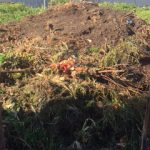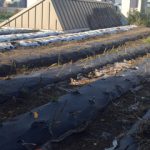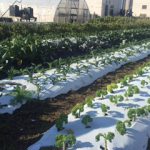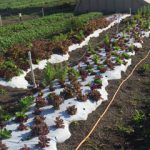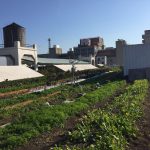On Monday October 17th, 2016, Professor Krondl took us heading to see the Brooklyn Navy Yard rooftop garden. The Brooklyn Navy Yard rooftop garden farming plants have many kind of vegetable like , carrots, tomatoes, lettuces, peppers kale and Chickens. They have soil all the way from Pennsylvania and doesn’t use pesticides, that lead to the crops are healthier and way different crops we purchase from the supermarket. Before the garden was set on the rooftop, most of the water runoff went to the sewage system and now they have water pump up to the water tank to create an automatic watering system. Also the chance for the rooftop to get amount rain and sun in New York City. I learned that how they make farming in a sustainable idea of being able to use resource over again and maintain a good amount of resource. It is totally environmental-friendly.
After reading the article “Supersize”, I feel like other state farming or conventional farming are way different from rooftop farming. The conventional farming show a large area and produce a huge amount of product every years or every months or even every weeks. It has a magnificent quantity result, but the negative side is using pesticides and chemical fertilizers. The reason is farming in a big farm there are large amount of insect in the fields, it is difficult for farmer to deal with them. So some farmer use pesticides to kill insect and also harm the plants. For chemical fertilizers make the product grow fast and quicker, eventually it will make the product may not seem most healthiest. In the rooftop garden is more focus on organic product so there won’t be any pesticides and chemical fertilizers in their farming.
In the United States, President Obama had the most issue on food system and there has to be change. He didn’t make any new act that seem to help the industry grow back up. The sustainability of agriculture is effected, for example the amount of fossil fuels is use during the transportation crops contributed great amount of CO2, cause pollution and global warming. The world need sustainability of ideas that can be environmental-friendly to fix the or minimize the negatives of farming.
Category Archives: Field Trip Post
Field Trip Blog- Isabella Velasquez
Sustainability can be best defined as the process to continue a defined behavior indefinitely. In other words to continue the definite works of nature without causing harm to the environment. On October 21, 2016 our class observed this by traveling to the roof top garden at the Brooklyn Navy Yards. We observed the many crops that were grown. As a class we learned how sustainability works and how to prevent harm to the environment.This was trip was both entertaining and educational. Many of the ideas Professor Krondl’s colleague explained and demonstrated, were also discussed in Michael Pollan’s article,”Big food strikes back”. Pollan primarily discusses the idea that it has been brought to the public’s attention, that our agricultural system is experiencing many defaults causing harm for the environment and potential economic risks. For instance Pollan illustrates that our current agricultural system is consequently causing various greenhouses to produce harm in our society. Not only is it causing the environment it is also causing a decline in our economy. This is demonstrated in the article when Pollan states “it’s creating monocultures that are vulnerable to national security threats, are now vulnerable to sky-high food prices or crashes in food prices, huge swings in commodity prices”. This evidence suggests that with these risks we as community should work together to prevent greenhouse gasses from harming our society.
Consequently, greenhouse gasses are causing harm, but with the knowledge our class acquired from the trip we can work together to help this environment. I believe that sustainability in our crops and farmland can be possible.
Field Trip Blog Danile’s Voice
On October 21 st my professor Mr.Krondl had taken our class to visit a building that has survived the war period and now serves a new purpose. We visited the Brooklyn Navy Yard to get a tour of a local farm. When I heard the word farm my first thought was a wide landscape that could provide food for at least half a million people, not what looked like a garden to me. We were told by our tour guide of the beautiful creation that this was made possible due to the building being reinforced to withstand any blows it took during the year 1806. This allows the farms to plant their goods on top the roof without the worry of everything falling through the roof. The farm has a variety of plants growing in it from the carrots under ground to the lettuce reaching for the sky. The people taking care of the small farm are aware of the trouble growing certain plants attract such as unwanted insects. To distract them from eating until the plants die they planted marigolds to keep the insects attention less on their important plant. all they crops on top the roof are sustained by a near by bee hie which pollinates the plants on the roof as well as other plants in the area. Not only does does the farm help local people it helps our environment as well. all the water from the rain is collected and used for the crops rather than adding to the gallons of water pushing tons of street garbage and containts into the near by river Using marigolds are one of the natural ways to avert the attention of insects whereas big farms more than the size of Rhode Island can’t afford any mistakes and use pesticides to keep the insects off their plants. Not the healthiest choice but it ensures that they don’t lose a big portion of their crops. When you compare a big farm like the one in California to the local farms around you, you start to see the difference. One obvious thing is that big farms take up more land than locals. They introduce chemicals to their crops, use tons of water to keep healthy, and are transported around the country to grocery store and restaurants. That is just the tip of the ice berg for big farms they are cheaper compared to local farms which have crops that are grown with no pesticides, in small portions, and don’t feed the country but do provide for a small community like a small farm in Detroit. Small farms have grown over a short time into massive producing farms but local farms are healthier and can be accessed quicker and be fresh for cooking. the community can really benefit from rooftop farms.
Field Trip (Green Market)
On October 21 I visited on of the Green Markets in Brooklyn. While everyone visited the magnificent rooftop garden, I got the chance to go see the Framers Market (Green Market) located on Carrol Street. A lot of farmers brought their own locally grown products. I looked around and the prices weren’t too expensive. I talked to some of the sellers there, and they said that they grew their own vegetables and bring them to the green market to sell. The market was on the street, and after the day is over everything gets cleaned up. I believe it’s very important that sellers bring their food into the city. That way people who live in the city don’t have to go upstate to buy farmers grown fruits and vegetables. This market ensures that all New Yorkers have fresh and naturally grown food to take home. I did a little research and found out that there is 54 Green Markets in the 5 boroughs and 24 of them operate year-round. It’s very important for the people that live in New York because a lot of times the food that we buy in supermarkets is not naturally grown. These markets will definitely help our city to stay healthier.
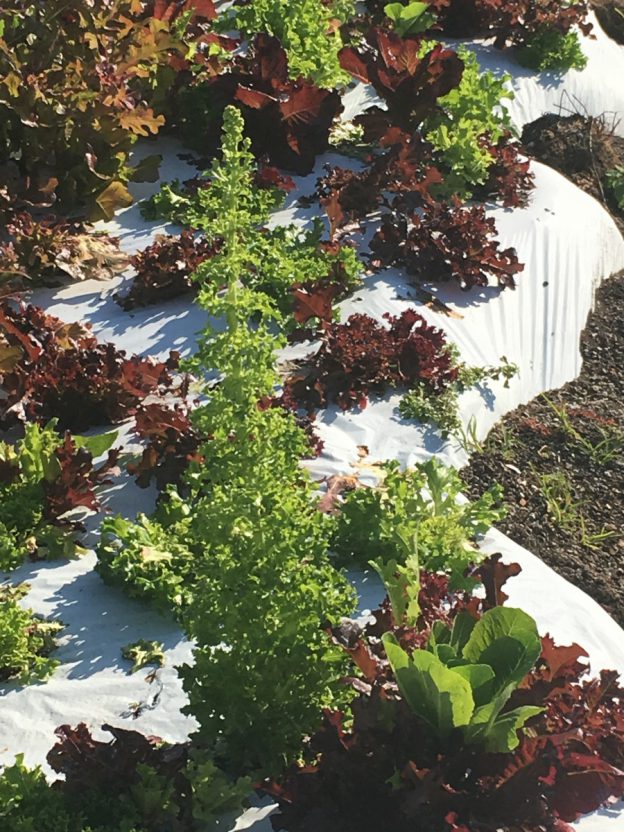
Field Trip Blog
In downtown Brooklyn, there is a magnificent rooftop garden, it is about an acre long as has many vegetables growing. During my trip, I saw the different kind of plant such as eggplants, cabbage, and lettuce. This was the first time I saw a rooftop garden; I was shock to see and learn how they could maintain such a garden. According to the professor they have a wide drainage system for rain water to run off, but the plant absorbs most to it and the plants get a lot of sunlight due to the hight of the building. During the winter, there is little greenhouses to grow new plants for the spring. All these plants are taking care by hands and not by machines like those in the movie “America revealed food machine”, where the land is larger and are required to be taking care by machines. These machine crop use fertilizers and pesticides to help grow their crop faster. Most of America use these crops rather than local growing crops, these crops are also altered and some don’t like the idea of that which is why they buy from local gardener. Local crops are much healthier than the machine crops, but not many have the time to grow or go out and buy these vegetables. Planting your own rooftop garden can save you a lot of money and a trip to the supermarket, plus you know that its healthy because you’re the one growing it. And on the other hand you will be helping the environment unlike the machine crops, they burn allot of fuel and are required to travel great distance, this can be consider one of the biggest greenhouse gas problem. Other the other hand food made from these subsidized corn, soy, feedlot meat and processed food of all kind is one of the leading factor in the rise of heath care cost. President Obama is concerned that the agriculture sector is producing more greenhouse gas than the transportation sector, and is now creating sky high prices and leads in contributing to type 2 diabetes, stoke, and heart disease. President Obama promises to work to fix this and solve our problem with the federal clean air and clean water acts.
Field Trip Post~Gloria Garcia
Last Monday the class went to the Brooklyn Grange which is a sustainable rooftop garden in the Brooklyn Navy Yard. The farm grows “over 50,000 lbs of organically-cultivated produce per year” which is then sold to CSA members, restaurants, and to the public. The Brooklyn Grange also operates an apiary and egg-laying hens, the honey is sold to the public. The Hospitality Garden Club from City Tech has an association with the farm, it teaches club members the basic skills of sustainable gardening. During club hours members maintain a neat and clean garden while they grow flowers and vegetables for the pastry and culinary labs at City Tech. The farm’s compost consists of food waste from individuals, restaurants and the garden itself in order to have a nutritious soil for the crops. There’s also no activity of pesticide use. The Brooklyn Grange mission is to produce healthier and nutritious crops compared to those sold in the supermarkets.
In the first episode of America Revealed “Food Machine”, Yul Kwon explores how the food is grown, processed, and transported in the United States in order to feed nearly 300 million Americans every day. The show displays how engineering has allowed 80% of California’s water to go to Central Valley farm which produces 50% of the entire country’s fruits, nuts, and vegetables. It also exhibits the use of antibiotics and growth hormones on animals just so it could provide a good amount of meat for a low price. All of these activities are affected by “craveability”, which is what Americans want and whatever is currently trending in the restaurant business. In order for all of the consumers to be satisfy, farms have to take different measures on how they operate from the use of more than 40 pesticides to hormones and antibiotics. Lastly, Kwon investigates Detroit where people can’t afford to get real food and it shows how urban farmer Will Gardner has been growing his own crops to eat and sell in a local farmer’s market. From the beginning and end of the show we see the great differences between both farming techniques and the impacts it has on the population it feeds.
Michael Pollan’s states in his article that President Obama did not address the broken food system like he should have and how quickly the Obamas were “outlobbied and outgunned” when poking at Big Food. Michelle Obama in the other hand did her best to promote a healthier lifestyle by focusing “on issues that resonated with ordinary Americans concerned about their children”. An accomplishment being the Healthy, Hunger-Free Kids Act of 2010 where she prioritized and raised “nutritional standards for the meals served in the Federal school lunch program” and eliminating the sale of junk food in public schools. Michelle Obama has set the start of the food movement, it is up to us to continue fighting for this movement to exist as a political force. At the end of the day we have to understand that it takes a lot of time to change the way agriculture has been operated in the past years, that’s one of the reasons why the Obamas didn’t make as much progress as we would have liked them to.
The Brooklyn Grange sets an excellent example of how farms/gardens should be operated and its interaction with the community by providing countless workshops and renting the area for yoga classes, wedding ceremonies and dinner parties. Farms that produce without the use of chemicals should be expanded to promote a healthier lifestyle since the other way of farming has caused several health issues. There should be more available resources like the Brooklyn Grange in necessary areas where it is not easy to afford organic products. Overall, sustainability should be reevaluated in our agriculture so there could be a balance in the foods that we consume.
Field Trip Post-Juan Torres
Sustainability is the idea of being able to use a resource over again and to maintain a good amount of resources available. This past week Monday professor Krondl took us to the Brooklyn Navy Yard to see the garden on the rooftop. On that rooftop City Tech had space to plant vegetables. Though it wasn’t just City Tech who planted vegetables their. There were many planted there alongside with live chickens and compost being made there to fertilize the soil. One of the essential features of this small garden rooftop is that it collects the majority of water that comes as it rains. The rain used to be a bigger problem before this rooftop garden as most of the runoff went into the sewage system and went into the waters unfiltered. But now most of that water is being collected by the garden.
This garden has an idea of sustainability as the crops can be grown again and again over a period of time. Though compared to the huge land masses in the other coast this garden produces nothing. The farms on the other coast provide fruits, vegetables, cattle and livestock. In the New York Times article ” Super Size” it shows production lines of these farms and how much they produce yearly Alongside the film we saw in class it shows the different production of foods, especially corn as it’s a big ingredient in many products. In the article “Big Food Strikes Back” by the New York Times talk about the big food corporations and how they want to keep the old practices that they have used. While it may not seem the most healthiest.
Field Trip Blog- Wilson Cordero
Sustainability is the process of something being used but never completely used up, it keeps going. This should be true for farming and is in some cases but not in greater scales like in the article supersize shows and in the video seen in class. The problem with bigger and greater farms is all the resources used that cant sustain its self. The amount of water they use is too much to keep up with so the farms are not sustainable and actually not good for the environment like smaller farms. Also in the other article Big Food Strikes Back it states that the agricultural part actually has more green house gas production than the transportation part.
On the other hand the smaller farms like the Brooklyn Grange that our class visited actually help the community. It doesn’t use a lot of anything so it can be easily sustained. It has close to none of green house gases and no carbon footprint. It does this because there’s no long distance to take the fresh produce and since its on a smaller scale there’s no massive amount of water being used or pesticides being used at all. This type of local farming is better than the big farms out west in basically every way possible.
Field Trip Blog – Jerry Quizhpi
Professor Krondl had taken our class to the Brooklyn Navy Yard to visit a rooftop farm on October 17th. The farm had many varieties of herbs and vegetables. There was also a place to grow chickens, which were well taken care of. Bees were everywhere around the garden and had a spot to make their honey which the farmers collected from. They had placed marigolds at the end of rows to provide protection against most insects. The rooftop farm was in a great place because since its an open area, it received lots of sunlight, had rain pour down on the crops to water them and any extra water would be stored inside a water tank which was placed near the farm. Nothing in this farm goes to waste and everything that can be decomposed goes together which creates new organic and nutritious soil for future plants. This farm is better compared to larger ones because according to the New York Times article “Supersize”, the larger farms will tend to use either pesticides or chemicals to get rid of pests that can harm their crops. It’s more efficient for large farms because its less time consuming and allows them to cover more area. Even though large farms provide a lot of crops per season, it’s still harmful for us because any unwashed produce can linger and eventually reach us as consumers. In the article “Big Food Strikes Back”, it speaks about how the president and the first lady weren’t able to do anything about modernizing agriculture. Without President Obama being able to place down any type of laws or acts, big corps are still able to continue to farm the way they are. It’s better for the world if people create farms that are natural and that don’t require huge amounts of pesticide or any harmful chemicals. It’s better for the Earth, and it’s better for consumers who purchase produce on a daily basis. Reducing the amount of chemicals used in farming can help out with current issues in our environment.
Prior to going on the class trip to the Brooklyn Navy Yard Rooftop Garden we watched a video called film called “Food Machine Episode 1 America Neverland”. The host Yul Kwon goes to all the most known places where we get our food resources from. In the film the host went to some of the most popular and largest farms in the United States. He reviewed and questioned the actions that the farmers make to make sure the food sources are available for us and in a timely manner. In the film the farmers shows what they have to do often to maintain the produce and what they have to do maintain it but adding GMO’s to some because the insect population increasing and messing up the food. But also, it messes up the population for plants that want to be considered organic. insects like bees and other flying insects can die off and messes up recourses that we get from insects like honey. And comparing the film to the Brooklyn Navy Yard and how they plant their food theirs a huge different. the roof top garden recourses aren’t really used for a huge amounts of people so timing is not so importing. It’s important to the people rely on the recourses like restaurants and households. at the Brooklyn Navy Yard they don’t use pesticides to help food consistency. just like in the winter the food at the navy yard wouldn’t be in good use to do to the fact of temperature change but in the larger farms on the other side of the united states its mostly warm only problem they might have is water supply. So it might be bad to have pesticides but food quicker or have organic garden that grow on a regular schedule.



